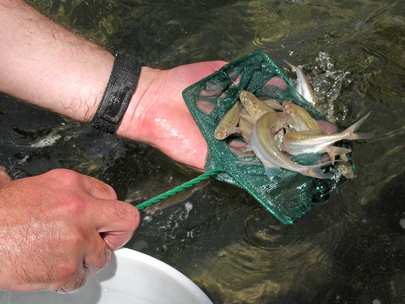
NPS/Allyson Mathis
Juvenile humpback chub being released into Shinumo Creek (June 2010)
Grand Canyon, Ariz. - In late June 2011, the National Park Service, in cooperation with the Bureau of Reclamation, the U.S. Fish and Wildlife Service, and the Arizona Game and Fish Department will translocate wild juvenile humpback chub to Shinumo Creek and to Havasu Creek below Beaver Falls in Grand Canyon National Park.
The translocation to Shinumo Creek on June 21 will be the third translocation to that tributary. The translocation of humpback chub to Havasu Creek on June 28 will be the first of three planned releases to that tributary. The main purposes of these conservation experiments are to assess whether additional populations of these endangered fish can be established through translocations into these tributaries.
The humpback chub (Gila cypha) is endemic to the Colorado River basin. The species is well adapted to natural conditions of the Colorado River with high turbidity and seasonally variable flows and temperatures. Humpback chub are endangered because of human-caused changes to the Colorado River ecosystem including the introduction of non-native fish species as well as dam-induced changes to the river's natural flow and temperature regimes. Today, the largest remaining population in the world is found near the confluence of the Colorado River and Little Colorado River in Grand Canyon.
The translocation of juvenile humpback chub to these Colorado River tributaries is part of a multi-faceted native fish recovery program for the Colorado River in Grand Canyon. These creeks may provide excellent rearing habitat for juvenile humpback chub. Shinumo Creek, which meets the Colorado River at River Mile 109, has a barrier waterfall just above its Colorado River confluence, which isolates habitat in the creek from non-native fish that may act as competitors or predators upon humpback chub in the mainstem Colorado River. Havasu Creek joins the Colorado River at River Mile 157 and is very similar to the Little Colorado River in water chemistry and physical habitat, and has fewer non-native fish predators than other Grand Canyon tributaries or the Colorado River.
In 2009 and 2010, a total of 602 juvenile humpback chub were translocated to Shinumo Creek. Data collected through February 2011 have shown that the majority of the translocated fish have remained in Shinumo Creek, and that fish growth rates are comparable or better than in the Little Colorado or Colorado Rivers.
The juvenile humpback chub that will be released in Shinumo and Havasu Creeks were captured in 2010 from Little Colorado River. The fish were treated to remove any parasites that may be present, kept overwinter, and then implanted with passive-integrated-transponder (PIT tags) to uniquely identify individual fish at the Bubbling Ponds Native Fish Hatchery operated by the Arizona Game and Fish Department in Cornville, Arizona.
Grand Canyon National Park Fisheries Program Manager Brian Healy said, "Havasu Creek is thought to be the most likely candidate to support a second population of humpback chub in Grand Canyon National Park, outside the Little Colorado River. The translocation experiment to Shinumo Creek has been successful so far, and we have high expectations for the Havasu Creek translocations."
Healy added, "Monitoring of native fish in the mainstem Colorado River has shown that tributary translocations may also augment native fish populations in the Colorado River."
Acting Grand Canyon National Park Superintendent Barclay Trimble said, "I'm excited about the upcoming humpback chub translocations to Shinumo and Havasu Creeks as part of our efforts to protect Grand Canyon's native fish species. The translocations to Shinumo Creek have been successful to date, and this conservation tool may turn out to be an important part of the recovery for this Colorado River native fish."
There are no closures at Shinumo or Havasu Creeks because of these translocation experiments. Fisheries biologists from the National Park Service, Bureau of Reclamation, U.S. Fish and Wildlife Service, and Arizona Game and Fish Department will survey the existing fish population in Shinumo and Havasu Creeks prior to the translocation, and conduct additional monitoring in September and October.
In order to minimize interference with recreational boaters at the mouth of Havasu Creek, crews will be dropped off by a river trip following the Shinumo translocation, and hike out of the canyon to Hualapai Hilltop following completion of the Havasu translocation. Crews will also camp away from the river. Healy said, "As part of the planning for this project, we carefully evaluated potential impacts to visitors and to the wilderness characteristics of Havasu Creek. Helicopter support for the survey and monitoring work, and for the transport of the young humpback chub, was determined to have the least impact to park resources and visitor experience, while minimizing stress to the fish"
Anglers should be familiar with the identifying characteristics of humpback chub to avoid any accidental capture of these endangered fish. Young humpback chub are silver, have small eyes and large fins, but have not yet developed the pronounced hump behind their head. If any humpback chub are incidentally caught, they must be immediately released unharmed.
For more information, please contact Brian Healy, Fisheries Program Manager at 928-638-7453 or Maureen Oltrogge, Public Affairs Officer, at 928-638-7779. Additional information on the 2010 Shinumo Creek humpback chub translocation, including a six-minute video, is available online at http://www.nps.gov/grca/naturescience/cynsk-v21.htm.


